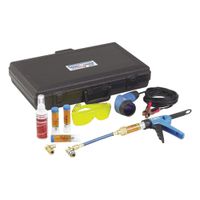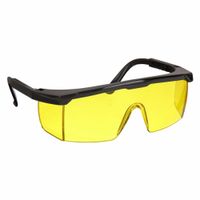Call +(254) 703 030 000 / 751 483 999 / 721 704 777
- Home
- Fleet Vehicle Maintenance
- Vehicle Tools
- Vehicle Diagnostic Tools
- Vehicle Leak Detectors
Vehicle Leak Detectors
Leak detectors can find refrigerant, oil, or gas leaks in a vehicle and identify smaller, harder-to-locate leaks other methods may fail to detect. A/C leak detectors identify leaking fluids in a vehicle's air conditioning system. UV glasses are yellow-tinted glasses that detect all types of injected .....Read More
Frequently Asked Questions
What is the best leak detector for refrigerants?
The best leak detector for refrigerants is often considered to be the Inficon D-TEK Select Refrigerant Leak Detector. This tool is highly regarded for its sensitivity, reliability, and ease of use. It utilizes an infrared sensor that provides consistent and accurate detection of all CFC, HCFC, HFC, and HFO refrigerants, including R-134a, R-410A, and R-1234yf. The D-TEK Select offers a sensitivity of 0.10 ounces per year, making it capable of detecting even the smallest leaks.
One of the standout features of the D-TEK Select is its sensor longevity, which can last up to 1,000 hours, reducing the need for frequent replacements and ensuring long-term cost-effectiveness. The detector also features a rechargeable NiMH battery, providing up to 6.5 hours of continuous operation, which is ideal for extended use in the field.
The ergonomic design of the D-TEK Select ensures comfortable handling, and its intuitive one-button operation simplifies the detection process. The tool also includes a flexible probe that allows for easy access to hard-to-reach areas, enhancing its versatility in various applications.
Additionally, the D-TEK Select is equipped with a visual and audible alarm system that alerts the user to the presence of refrigerant leaks, ensuring that leaks are identified quickly and efficiently. The adjustable sensitivity settings allow users to tailor the detector's performance to specific needs, further enhancing its effectiveness.
Overall, the Inficon D-TEK Select is widely considered the best refrigerant leak detector due to its high sensitivity, durability, and user-friendly features, making it a preferred choice for HVAC professionals and technicians.
How do A/C leak detectors work?
A/C leak detectors are tools used to identify and locate refrigerant leaks in air conditioning systems. They work by detecting the presence of refrigerant gases that escape from the system. There are several types of A/C leak detectors, each utilizing different technologies:
1. **Electronic Leak Detectors**: These are the most common type. They use a sensor to detect changes in the concentration of refrigerant gas in the air. When the sensor detects a higher concentration of refrigerant, it triggers an alarm or a visual indicator. These detectors are sensitive and can detect even small leaks.
2. **Ultrasonic Leak Detectors**: These devices detect the sound of refrigerant gas escaping from the system. When a leak occurs, it creates a high-frequency sound that is often inaudible to the human ear. Ultrasonic detectors pick up these sounds and convert them into audible signals or visual indicators.
3. **Dye Leak Detectors**: In this method, a fluorescent dye is added to the A/C system. The dye circulates with the refrigerant and escapes through any leaks. Using a UV light, technicians can visually inspect the system for the presence of the dye, which glows under the light, indicating the location of the leak.
4. **Halide Torch Detectors**: These are older devices that use a flame to detect refrigerants. When the flame is exposed to refrigerant gas, it changes color, indicating a leak. This method is less common today due to safety concerns and the availability of more advanced technologies.
Each type of detector has its advantages and limitations, and the choice of detector often depends on the specific requirements of the job, such as the type of refrigerant used and the size of the system.
Can UV glasses detect all types of leaks in a vehicle?
No, UV glasses cannot detect all types of leaks in a vehicle. UV glasses are typically used in conjunction with a UV dye and a UV light source to identify leaks in systems that contain fluids, such as air conditioning, coolant, or oil systems. The process involves adding a UV-reactive dye to the fluid system, running the system to circulate the dye, and then using a UV light and glasses to spot any leaks where the dye fluoresces.
However, this method is limited to systems where a UV dye can be safely added and is effective only for detecting leaks of fluids that can carry the dye. It cannot detect leaks in systems that do not use fluids, such as vacuum leaks, exhaust leaks, or air leaks in tires. Additionally, it is not suitable for detecting leaks in electrical systems or for identifying issues like gasket failures or structural cracks that do not involve fluid leakage.
For comprehensive leak detection, other methods and tools are required, such as smoke machines for vacuum leaks, soapy water for air leaks, or electronic leak detectors for refrigerant leaks. Each type of leak may require a specific approach and toolset for accurate detection and repair.
What are the signs of a refrigerant leak in a car?
1. **Reduced Cooling Efficiency**: The air conditioning system may not cool the car as effectively, taking longer to reach the desired temperature or failing to cool at all.
2. **Hissing Sounds**: A hissing or bubbling noise may be heard when the AC is running, indicating a possible leak in the system.
3. **Oily Residue**: Refrigerant leaks often leave an oily residue around the AC components, such as hoses, connections, or the compressor.
4. **Visible Leaks**: You might notice visible signs of leakage, such as a green or orange dye if a UV dye was used in the refrigerant.
5. **AC Clutch Not Engaging**: The AC compressor clutch may fail to engage due to low refrigerant levels, preventing the system from functioning.
6. **Increased Humidity**: The car's interior may feel more humid than usual, as the AC system struggles to remove moisture from the air.
7. **Unusual Smells**: A chemical smell inside the car when the AC is on can indicate a refrigerant leak.
8. **Frequent Cycling**: The AC system may cycle on and off more frequently than normal, indicating a problem with maintaining pressure.
9. **Dashboard Warning Light**: Some vehicles have a warning light on the dashboard that may illuminate if there is an issue with the AC system.
10. **Frost on AC Components**: Frost or ice may form on the AC components, such as the evaporator or lines, due to improper refrigerant levels.
11. **Higher Fuel Consumption**: The engine may work harder to compensate for the inefficient AC system, leading to increased fuel consumption.
How do you use a UV dye to find a leak?
To use a UV dye to find a leak, follow these steps:
1. **Select the Appropriate Dye**: Choose a UV dye compatible with the system's fluid (e.g., oil, coolant, refrigerant).
2. **Add the Dye**: Introduce the dye into the system. For automotive systems, pour the dye into the oil filler cap, coolant reservoir, or refrigerant line, depending on the type of leak you are investigating.
3. **Run the System**: Operate the system to circulate the dye. For vehicles, run the engine or air conditioning system for a sufficient period to ensure the dye mixes thoroughly with the fluid.
4. **Inspect with UV Light**: Turn off the system and use a UV flashlight or lamp to inspect the area. Wear UV-protective glasses to enhance visibility and protect your eyes.
5. **Identify the Leak**: In a darkened environment, shine the UV light on the system components. The dye will fluoresce under UV light, revealing bright, glowing traces at the leak source.
6. **Trace the Leak Path**: Follow the glowing dye trail to pinpoint the exact location of the leak. Check all potential leak points, such as hoses, seals, and connections.
7. **Repair the Leak**: Once identified, repair the leak using appropriate methods, such as tightening connections, replacing seals, or patching holes.
8. **Clean the Area**: After repairs, clean the area to remove any residual dye, ensuring no false positives in future inspections.
9. **Recheck for Leaks**: Run the system again and perform another UV inspection to confirm the leak is fixed and no new leaks have developed.
Are electronic leak detectors more accurate than UV dye methods?
Electronic leak detectors are generally more accurate than UV dye methods for detecting refrigerant leaks. Electronic detectors can identify leaks by sensing the presence of refrigerant gases in the air, often down to very low concentrations, which allows for the detection of even small leaks. They provide immediate results and can be used to scan large areas quickly.
In contrast, UV dye methods involve adding a fluorescent dye to the system, which circulates with the refrigerant. Leaks are identified by visually inspecting the system with a UV light to spot the dye. While effective, this method can be less precise, as it requires a visual inspection and may not detect very small leaks until they become larger. Additionally, the dye can take time to circulate and become visible at the leak site.
Electronic detectors are also advantageous in that they do not require the introduction of any foreign substances into the system, which can be a concern with UV dyes. However, electronic detectors can be sensitive to environmental conditions and may require regular calibration to maintain accuracy.
Overall, while both methods have their uses, electronic leak detectors are typically more accurate and efficient for detecting refrigerant leaks, especially in professional settings where precision and speed are critical.
How often should you check for leaks in a vehicle's A/C system?
You should check for leaks in a vehicle's A/C system at least once a year, typically during a routine maintenance check or before the start of the warmer months when the A/C system is used more frequently. Regular inspections can help identify potential issues early, preventing more significant problems and costly repairs. Additionally, if you notice any signs of a leak, such as reduced cooling efficiency, unusual noises, or visible refrigerant leaks, you should have the system checked immediately. Regular checks ensure the system operates efficiently, maintains optimal performance, and extends the lifespan of the A/C components.

